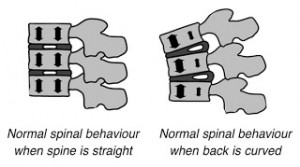If the spine is bent in any of its natural possible directions, the disk between two vertebrae acts as cushion that simply allows this movement to take place (see drawing). As we get older there is a natural degeneration in the cushion through wear and tear. Similar to a cushion we sit on, which goes flat over the years, the disk material gradually gives under the pressure of the bones they move and carry. This degeneration leads to increasing stiffness in the joint.
Bad posture, back damaging work practices and effects of injuries can have a continuously stressing effect increasing the pressure on one or more disks and can dramatically speed up the process of wear and tear. As part of this degenerative process, a vertebrae or disk might start to press on nerve tissue interfering with nerve functions causing pain, tingling sensations etc. Back problems or back pain can also be caused by the continuous tension of a muscle through bad posture, extensive strain or after an injury. The muscle tightens up and goes into a spasm. These tight muscles bulk and can press on nerves passing in and out of the vertebrae creating symptoms such as numbness, tingling and other problems.
In any case, if you experience pain in your back you must consult a doctor and clarify the source of the pain, prior to commencing an exercise class. This is simply necessary because some back pain might be the result of a condition that would require special medical attention (eg. tumours, osteoporosis). Specific and specialised exercise programmes are a key element in treating many conditions associated with back pain. It is always recommended to exercise as a preventative measure simply to maintain or improve health to keep the body in a physically well-toned condition.
In the next post we will examine how the muscles in your back and exercise affects your posture. You will learn what type of back strengthening exercises are the most beneficial for your back problems.

